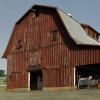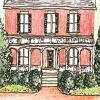Athens Rising
What's Up in New Development

The Jackson Street Building, a classic example of modernist architecture, is now more energy-efficient.
Athens is a historic town. We have several historic districts and a university all worth preserving. When thinking of historic cities, though, the first one that always comes to my mind is Charleston, SC.
While Athens doesn’t have quite the history of Charleston, there is a lot we can learn from the way Charleston has been preserved. Last week, I attended the kick-off of the Athens Clarke Heritage Foundation’s 2012–2013 Preservation Matters education series themed "Creative Living in Historic Cities." Jonathan Poston, director at the Hay House in Macon, gave a lecture at the UGA Chapel on how to marry preservation, tourism and livability in historic cities. Poston worked with the Historic Charleston Foundation for 20 years, and so his lecture was mostly centered on the livability of Charleston as a historic city.
Other than some drunken fans in the fall—not that I’m complaining—Athens doesn’t have the concerns Charleston has over tourism, which got out of control until the city passed laws to reign in bars and tours. I would like to see more tourism in Athens, since it could be a great way to boost our economy and keep small local businesses in town. While tourism might not be a problem for Athens, Poston did highlight some ordinances Charleston has adopted that would be beneficial here as well.
Until the construction of Charleston Place, a large boutique hotel at the end of Meeting Street, Charleston did not have high-rise buildings. Charleston Place made Charlestonians realize that the skyline of their city was in danger of being irrevocably changed; the city now has height limits.
The story of Charleston Place made me think of several very tall buildings in our own historic district: Athens First, 909 Broad St., Gameday, the Washington Street parking deck, etc. Currently, downtown Athens buildings are limited to 100 feet, but height is becoming an issue. The taller new construction becomes, the more out-of-place our historic buildings begin to look. We are also faced with the problem of very large, out-of-scale buildings in our historic district. In earlier articles, I have mentioned the fear of McMansions coming to several of Athens' historic residential districts, but what about the commercial McMansions coming to our historic commercial district? Do buildings in downtown really need to take up an entire block? Hopefully, with the development of the long-awaited downtown master plan we can follow Charleston in tweaking our height and scale ordinances.
Charleston also faces the problem—as does Athens, especially in the last year or so—of historic buildings being used for commercial chains. Poston told us of one store, in particular, that had been a jewelry store owned by the same family for over 100 years and is now a Puma store. Will Puma respect the historic interior of the building as much as the family who had owned it for 100 years?
But enough about how wonderful Charleston is. Athens is a great place, too! Visit the newly reopened Jackson Street Building (formerly the Lamar Dodd School of Art), home of the College of Environment and Design’s Landscape Architecture undergraduate program (the master’s program is still located in Denmark Hall with Historic Preservation), the Owens Library and several galleries for the college. The ACHF and CED co-hosted the reception following Poston’s lecture at the Jackson Street Building. Wayde Brown, a professor in the Historic Preservation Department, gave an architectural tour, and Assistant Vice President for Facilities Danny Sniff gave a sustainability tour.
Joseph Amisano, one of the most celebrated architects in Atlanta from the 1960s through the 1980s, designed the Jackson Street Building in 1962. The majority of UGA’s mid-century modern buildings, such as Stegeman Coliseum, are located on South Campus, making the Jackson Street Building stand out on North Campus. Originally designed for art students, it was a perfect fit for the landscape architects who also need lots of studio space, while still having a few small classrooms and large lecture halls.
More than 95 percent of the original building has been reused, and there have been some major retrofits to create a more sustainable building than originally constructed. The building was constructed with lots of windows so studios would be able to utilize natural light. These windows have been retrofitted with newer, more energy-efficient glass to cut down on energy costs. The building also uses “chilled beams” located on the ceiling of the south gallery to help with energy efficiency. Cool water runs through the beams to chill the surrounding air; as hot air rises, the beams cool the hot air, which in turn drops down to cool students, and the cycle repeats itself. This process is 25 percent more energy efficient than using forced air, such as an air conditioner.
In addition to chilled beams and energy-efficient glass, 72 solar panels have been added to the half-arches on the southern end of the building. These panels are capable of powering 189 laptop computers every day. Rooftop rainwater is also being harvested in a cistern to cut down on the amount of potable water being used in the building. A “dashboard” (i.e., a fancy touch-screen computer) is located in the main hallway and tells the energy used by each system every day, making it easy to see just how sustainable the Jackson Street Building is.
More by Stella Smith
-

Is the Chain Gang Taking Over Downtown Athens?
Local businesses are closing or moving and chains are taking their place.
-

-

A Historic Garden Is Coming to the Ware-Lyndon House
No one knows what it might have looked like, but they're giving it their best shot.









comments